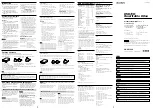
Section 3 - On the Water
90-879172181
eng
FEBRUARY 2011
Page 53
Under typical operating conditions Skyhook is capable of holding the vessel within a radius of 10 meters (30 feet). However this
distance may sometimes increase to a radius of 30 meters (100 feet). Do not engage Skyhook when the vessel is within 30 meters
(100 foot) of any obstacle, obstruction, dock, bridge, vessel, swimmer, etc.
While in Skyhook, it is essential the captain remain at the helm prepared to take control of the vessel due to changing conditions
such as:
•
A swimmer or another vessel approaches your vessel.
•
Skyhook loses the satellite signal and automatically disengages.
•
The size of the area in which the vessel is being held increases.
Before engaging Skyhook, the captain should brief all passengers on how Skyhook operates. Direct them to stay out of the water,
not to sit or stand where they could fall overboard, and to be alert for any sudden shifts in the vessel’s position. Occasionally the
Skyhook system may apply a brief surge in power to hold a position. If passengers are not prepared for this occurrence they may
lose their balance and fall.
!
WARNING
A rotating propeller, a moving boat, or a device attached to a moving boat can cause serious injury or death to people in the
water. When Skyhook is engaged, the propellers rotate and the boat moves to maintain the position of the boat. Stop the engines
immediately whenever anyone is in the water near the boat.
Skyhook will not engage unless the joystick and control levers are in neutral. When Skyhook is engaged, the propellers turn but,
the rotation may not be obvious. Ensure that no one is in the water near the vessel within 30 meters (100 feet) and the passengers
are secure when the engines are running.
When Skyhook is engaged the captain must:
•
Remain at the helm
•
Watch closely for anyone in the water near the vessel
•
Disengage Skyhook if anyone enters the water or approaches the vessel from the water
•
Watch for approaching vessels and disengage Skyhook if any vessel is on an intercept course
Skyhook system response will change with wind and current conditions. Familiarize yourself with how best to position your vessel
regarding the speed and direction of wind and current. When you place the bow into the wind, the Skyhook system response is
smoother. Experiment to determine what works best for your vessel in various situations.
Occasionally the GPS signal may weaken or become temporarily unavailable. When this happens Skyhook will sound an alarm
and automatically disengage. The drives will return to neutral and the vessel will drift with the wind and current. You must be ready
to take control of the helm at all times.
IMPORTANT: Activities in the water near the vessel while Skyhook is engaged may result in injury or death. The captain, operator,
and passengers should read and observe the safety warning labels on the vessel before Skyhook is engaged.
The following safety warning labels are located on the vessel for reference.
33798
8M0034159
Label adjacent to the Precision Pilot trackpad
Summary of Contents for 92-858058K01
Page 4: ......
Page 8: ...Page iv 90 879172181 eng FEBRUARY 2011...
Page 78: ...Section 3 On the Water Notes Page 70 90 879172181 eng FEBRUARY 2011...
Page 128: ...Section 5 Maintenance Notes Page 120 90 879172181 eng FEBRUARY 2011...
Page 140: ...Section 7 Troubleshooting Notes Page 132 90 879172181 eng FEBRUARY 2011...
Page 146: ...Section 8 Customer Assistance Information Notes Page 138 90 879172181 eng FEBRUARY 2011...
















































